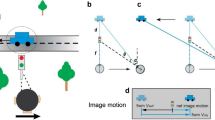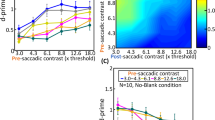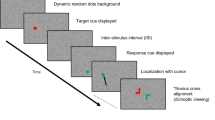Abstract
We are usually unaware of the motion of an image across our retina that results from our own movement. For instance, during slow-tracking eye movements we do not mistake the shift of the image projected onto the retina for motion of the world around us, but instead perceive a stable world. Following early suggestions by von Helmholtz1, it is commonly believed that this spatial stability is achieved by subtracting the retinal motion signal from an internal reference signal, such as a copy of the movement command (efference copy)2,3,4. Object motion is perceived only if the two differ. Although this concept is widely accepted, its anatomical underpinning remains unknown. Here we describe the case of a patient with bilateral extrastriate cortex lesions, suffering from false perception of motion due to an inability to take eye movements into account when faced with self-induced retinal image slip. This is indicated by the fact that during smooth-pursuit eye movements, he perceives motion of the stationary world at a velocity that corresponds to the velocity of his eye movement; that is, he perceives the raw retinal image slip uncorrected for his own eye movements. We suspect that this deficiency reflects damage of a distinct parieto-occipital region that disentangles self-induced and externally induced visual motion by comparing retinal signals with a reference signal encoding eye movements and possibly ego-motion in general.
This is a preview of subscription content, access via your institution
Access options
Subscribe to this journal
Receive 51 print issues and online access
$199.00 per year
only $3.90 per issue
Buy this article
- Purchase on Springer Link
- Instant access to full article PDF
Prices may be subject to local taxes which are calculated during checkout




Similar content being viewed by others
References
von Helmholtz, H. Physiological Optics Vol. III(Dover, New York, (1962)) (trans. from 3rd German edn of 1910).
von Holst, E. & Mittelstaedtt, H. Das Reafferenzprinzip. Naturwissenschaften 37, 464–476 (1950).
Sperry, R. W. Neural basis of the spontaneous optokinetic response produced by visual inversion. J. Comp. Physiol. Psychol. 43, 482–489 (1950).
Wertheim, A. H. Motion perception during self-motion: the direct versus inferential controversy revisited. Behav. Brain Sci. 17, 293–355 (1994).
Filehne, W. Über das optische Wahrnehmen von Bewegungen. Z. Sinnesphysiol. 53, 134–145 (1922).
Mack, A. & Herman, E. Position constancy during pursuit eye movements: an investigation of the Filehne illusion. Q. J. Exp. Psychol. 25, 71–84 (1973).
Haarmeier, T. & Thier, P. Modification of the Filehne illusion by conditioning visual stimuli. Vis. Res. 36, 741–650 (1996).
Haarmeier, T. & Thier, P. An electrophysiological correlate of visual motion awareness in man. J. Cogn. Neurosci.(in the press).
Rizzo, M., Nawrot, M. & Zihl, J. Motion and shape perception in cerebral akinetopsia. Brain 118, 1105–1127 (1995).
Regan, D., Kothe, A. C. & Sharpe, A. Recognition of motion-defined shapes in patients with multiple sclerosis and optic neuritis. Brain 114, 1129–1155 (1991).
Herbst, H., Ketabi, A., Thier, P. & Dichgans, J. Comparison of psychophysical and evoked potential methods in the detection of visual deficits in multiple sclerosis. Electroenceph. Clin. Neurophysiol. 104, 82–90 (1997).
Haarmeier, T. & Thier, P. Impaired dynamic visual acuity due to deficient smooth pursuit eye movements. Soc. Neurosci. Abstr. 23, 1950 (1997).
Komatsu, H. & Wurtz, R. J. Relation of cortical areas MT and MST to pursuit eye movements. I. Localization and visual properties of neurons. J. Neurophysiol. 60, 580–603 (1988).
Komatsu, H. & Wurtz, R. J. Relation of cortical areas MT and MST to pursuit eye movements. III. Interaction with full-field visual stimulation. J. Neurophysiol. 60, 621–644 (1988).
Erickson, R. G. & Thier, P. Aneuronal correlate of spatial stability during periods of self-induced visual motion. Exp. Brain Res. 86, 608–616 (1991).
Ilg, U. J. & Thier, P. Inability of rhesus monkey area V1 to discriminate between self-induced and externally induced retinal image slip. Eur. J. Neurosci. 8, 1156–1166 (1996).
Tootell, R. B. et al. Functional analysis of human MT and related visual cortical areas using magnetic resonance imaging. J. Neurosci. 15, 3215–3230 (1995).
Zeki, S. et al. Adirect demonstration of functional specialization in human visual cortex. J. Neurosci. 11, 641–649 (1991).
Lieberman, H. R. & Pentland, A. P. Microcomputer-based estimation of psychophysical thresholds: the best PEST. Behav. Res. Methods Instr. 14, 21–25 (1982).
McKee, S. P., Klein, S. A. & Teller, D. Y. Statistical properties of forced choice psychometric functions: implications of probit analysis. Percept. Psychophy. 37, 286–298 (1985).
Acknowledgements
We thank patient R.W. for participating in our experiments. Supported by KFG ‘Neuroophthalmologie’.
Author information
Authors and Affiliations
Corresponding author
Rights and permissions
About this article
Cite this article
Haarmeier, T., Thier, P., Repnow, M. et al. False perception of motion in a patient who cannot compensate for eye movements. Nature 389, 849–852 (1997). https://doi.org/10.1038/39872
Received:
Accepted:
Issue Date:
DOI: https://doi.org/10.1038/39872
This article is cited by
-
Dreaming of a stable world: vision and action in sleep
Synthese (2021)
-
Bodily awareness and novel multisensory features
Synthese (2021)
-
Corrective saccades influence velocity judgments and interception
Scientific Reports (2019)
-
Cortical modulation of sensory flow during active touch in the rat whisker system
Nature Communications (2018)
-
Eye position information is used to compensate the consequences of ocular torsion on V1 receptive fields
Nature Communications (2014)
Comments
By submitting a comment you agree to abide by our Terms and Community Guidelines. If you find something abusive or that does not comply with our terms or guidelines please flag it as inappropriate.



